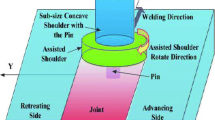Abstract
Reverse dual-rotation friction stir welding (RDR-FSW) is a novel variant of conventional FSW process. The key feature is that the tool pin and the assisted shoulder rotate reversely and independently during the process; thus, it has great potential to improve the weld quality and lower the welding loads through adjusting the rotating speeds of the tool pin and the assisted shoulder independently. In this study, a 3D model of RDR-FSW process is developed to conduct the numerical simulation of heat generation, material flow, and temperature profile during the process. Heat generated due to plastic deformation and friction at the tool-workpiece contact interfaces are both considered. Streamlines show that there are two material flows with reverse direction, which is beneficial to the uniformity of both the temperature and the microstructure at the advancing side and retreating side. The simulation results show that rotating speeds of the assisted shoulder and the tool pin have great effects on the shape and size of the thermo-mechanically affected zone (TMAZ). The calculated peak temperatures at typical locations match with the experimentally measured ones. It lays solid foundation to optimize the process parameters in RDR-FSW.










Similar content being viewed by others

References
Mishra RS, Ma ZY (2005) Friction stir welding and processing. Mater Sci Eng R 50(1–2):1–78
Nandan R, DebRoy T, Bhadeshia HKDH (2008) Recent advances in friction stir welding-process, weldment structure and properties. Progr Mater Sci 53:980–1023
Chen C, Kovacevic R (2004) Thermomechanical modeling and force analysis of friction stir welding by the finite element method. J Mech Eng Sci 218(5):509–519
Zimmer S, Langlois L, Laye J (2009) Experimental investigation of the influence of the FSW plunge processing parameters on the maximum generated force and torque. Int J Advan Manuf Technol 47(1–4):201–215
Li JQ, Liu HJ (2013) Effects of welding speed on microstructures and mechanical properties of AA2219-T6 welded by the reverse dual-rotation friction stir welding. Int J Advan Manuf Technol 68(9–12):2071–2083
Thomas WM, Norris IM, Staines DG, Watts ER (2005) Friction stir welding—process developments and variant techniques. The SME Summit 2005, Oconomowoc, Milwaukee, USA
Li JQ, Liu HJ (2013) Characteristics of the reverse dual-rotation friction stir welding conducted on 2219-T6 aluminum alloy. Mater Design 45:148–154
Shi L, Wu CS, Liu HJ (2014) Modeling the material flow and heat transfer in reverse dual-rotation friction stir welding. J Mater Eng Perform 23(8):2918–2929
Shi L, Wu CS, Liu HJ (2014) Numerical analysis of heat generation and temperature field in reverse dual-rotation friction stir welding. Int J Advan Manuf Technol 74(1–4):319–334
Nandan R, Roy GG, Lienert TJ, DebRoy T (2007) Three-dimensional heat and material flow during friction stir welding of mild steel. Acta Mater 55:883–895
Cho HH, Hong ST, Roh JH, Choi HS, Kang SH, Steel RJ, Han HN (2013) Three-dimensional numerical and experimental investigation on friction stir welding processes of ferritic stainless steel. Acta Mater 61:2649–2661
Wu CS, Zhang WB, Shi L, Chen MA (2012) Visualization and simulation of the plastic material flow in friction stir welding of aluminum alloy 2024 plates. Trans Nonferr Metal Soc China 22(6):1445–1451
Sheppard T, Jackson A (1997) Constitutive equations for use in prediction of flow stress during extrusion of aluminium alloys. Mater Sci Technol 13(3):203–209
Schmidt H, Dickerson TL, Hattel J (2006) Material flow in butt friction stir welds in AA2024-T3. Acta Mater 54:1199–1209
Awang M, Mucino VH, Feng Z, David SA (2005) Thermomechanical modeling of friction stir spot welding (FSSW) process: use of an explicit adaptive meshing scheme, Proceedings of the SAE 2005 World Congress & Exhibition, 2005 April 11–14
Mehta M, Chatterjee K, De A (2013) Monitoring torque and traverse force in friction stir welding from input electrical signatures of driving motors. Science and Technology of Welding and Joining 18(3):191–197
Zhang Z, Xiao BL, Ma ZY (2014) Hardness recovery mechanism in the heat-affected zone during long-term natural aging and its influence on the mechanical properties and fracture behavior of friction stir welded 2024Al–T351 joints. Acta Mater 73:227–239
Acknowledgments
The authors are grateful to the financial support for this research from the State Key Laboratory of Advanced Welding and Joining at Harbin Institute of Technology in China (Grant No. AWJ-Z13-02) and the Sino-German Center for the Promotion of Science (Grant No. GZ-739). The authors are grateful to the Editor, the Associate Editor, and anonymous reviewers for their insightful comments which have helped to improve the quality of the paper.
Author information
Authors and Affiliations
Corresponding author
Additional information
Doc. IIW-2550, recommended for publication by Study Group SG-212 “The Physics of Welding”
Rights and permissions
About this article
Cite this article
Shi, L., Wu, C.S. & Liu, H.J. Analysis of heat transfer and material flow in reverse dual-rotation friction stir welding. Weld World 59, 629–638 (2015). https://doi.org/10.1007/s40194-015-0238-z
Received:
Accepted:
Published:
Issue Date:
DOI: https://doi.org/10.1007/s40194-015-0238-z


